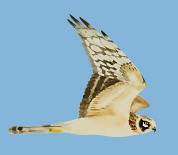Her på Skagen Fuglestations blog bringes korte nyheder i dagbogsformat om hændelser på fuglestationen.
Station’s first short-eared owl !
Hi everyone,
Yesterday night was very full of surprises : Hanelie and I were catching jack snipes Enkeltbekkasin at Cormorant Lake when Simon called us off, for the very good reason that Diana and Aksel caught a purple sandpiper Sortgrå Ryle at the tip of Grenen ! This little wader usually breeds in arctic and subarctic region of Eurasia and North America, and migrates south enough in winter for all of its populations to be on ice-free grounds. There, they are closely attached to rocky islands, peninsula and other coastal sectors exposed to vigorous wave actions ; they can also be attracted by breakwaters such as the ones at Grenen, if they provide comparable conditions.
As everybody started to go head home after the birds were ringed, measured, photographed, and released, I saw Lisa running back to the lab to grab the hand net and the flashlight. “What’s going on ?”, I asked, dubious ; “We saw an owl sitting on the road, we’re going to trap it now !”, she replied. I waved them good luck and went back up ; next thing I know, Simon called us saying they trapped it. Needless to say we’ve never rushed out of the flat so fast ! (Funny story, the guests didn’t believe Simon at first when he called them to announce the good news ; fortunately Diana banged on their door to gather everybody.)
This stunning juvenile female short-eared owl Mosehornugle is the very first (of many ?) caught since the opening of the station, 5 years ago. Although short-eared owls mostly hunt at night, they are known to be diurnal and crespuscular as well, making them easier to spot than their fellow nocturnal raptor. The species has a widely spread repartition, as it is occurring on every continent, apart from Oceania and Antarctica ; northernmost populations are largely migrating south during winter, on the contrary of other more tropical population which are usually year-round resident. Fun fact, this species’s clutch size usually ranges from 4 to 7 eggs, and can go up to 12!
After all the excitement, we got to bed quite late ; courageous Prescillia still woke up early and braved the wind to go observing at World End 3, where she spotted 3 purple sandpipers, of which none seemed to have a ring (yet). The rest of us had a bit more rest and then had separate activities ; Diana went observing at Elle Krattet while Aksel tried to fix a puncture in one of our bike’s tire and I worked on my presentation again. In the meantime, Simon had meetings with a colleague about new project to be implemented for BirdLife Denmark.
After lunch, Aksel and Diana worked on building new traps for snowbuntings, before Hanelie gave us an informative session about ageing and sexing both reed buntings Rørspurv and yellowhammers ; Simon then displayed pictures of the waders and owl caught last night for us to compare them with pictures of other individuals of different sex or age.

At the moment, Hanelie went to the tip to see the purple sandpipers while Diana, Prescillia and I share the good news on social media ; Aksel is cooking a new recipe that smells amazingly good, to give us strength for this evening’s night catching session. Let’s hope for more surprises !
People at the station : Diana Sciandra, Hanelie Sidhu, Solenn Boucher, Prescillia Lemesle, Aksel Munkholm, Simon S. Christiansen, Lisa Vergin and our guests Stig and Grethe
Today’s observations of the area on DOFBasen
Ringing :
Enkeltbekkasin : 2 (Cormorant Lake)
Sortgrå Ryle : 1 (Wolrd End 3)
Mosehornugle : 1 (Fyrhaverne)





